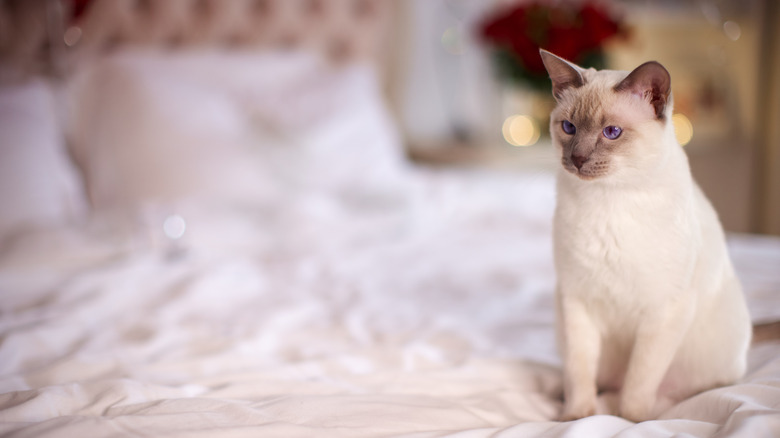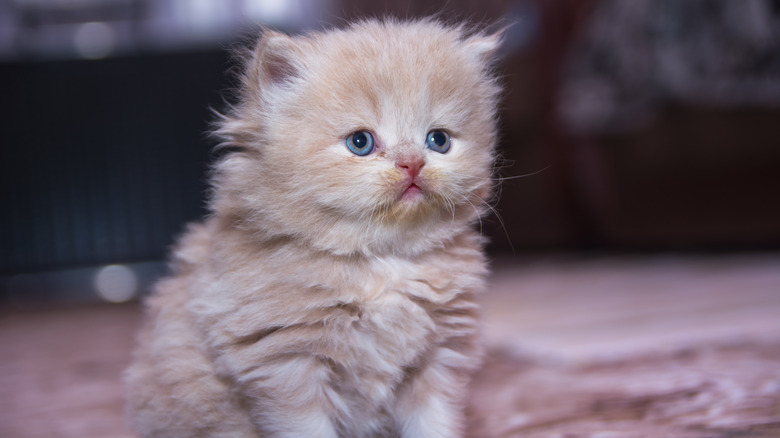One Of The Rarest Cat Colors Is A Shade Of Purple You Might Not Have Seen Before
When you think of cat colors, shades of brown, black, and white might come to mind. However, one of the rarest feline coat colors is the lilac coloration — a subtle, lavender-tinged hue that's as fascinating as it is beautiful. Lilac-colored felines are not entirely purple, but their pale brown hair has a unique undertone that gives off a soft lavender or pinkish sheen. Much like cats with the not often seen chinchilla coat, this striking appearance sets them apart in the feline world.
The lilac hue is considered a rarity due to the specific genetic makeup required to produce it. Both parent felines must carry and pass on recessive genes that combine to create the delightful shade. Because of this, lilac cats are often the result of carefully planned domestic breeding, making their existence even more extraordinary.
In addition to being visually unique, this lavender coloration also comes with a touch of exclusivity. Seen in breeds such as the vocal Siamese, adorable Persian, and colorpoint shorthair (a crossbreed of the Siamese and American shorthair), lilac-colored cats embody a blend of elegance and genetic alchemy.
The science behind purple cats
The soft, silvery-lavender coat known as lilac in cats is the result of a precise genetic combination. Several genes influence this feline coat color: B (black), its recessive counterpart b (chocolate), and d (dilution). To achieve the lilac shade, a cat must inherit two copies of both the chocolate gene (b/b) and the dilution gene (d/d), making this trait a product of two recessive genes working together. The chocolate gene modifies the black pigment resulting in a rich, warm brown tone. When the cat also carries the dilution gene, this chocolate base is lightened even further, producing the distinctive whisper-soft lilac color. Essentially, lilac is a diluted form of chocolate, which in turn is a lighter version of black.
Lilac-colored cats appear in several breeds. Solid lilac coats — characterized by an even, pale lavender hue — are seen in breeds like the British Shorthair and Burmese. The lilac point pattern, found in Siamese and colorpoint shorthair cats, highlights their ears, paws, and tails with soft lilac accents. Beyond these common patterns, the Thai Lilac, a rare variation of the Korat breed, stands out with its stunning bluish-lavender coat and striking green eyes.
Each of these breeds brings its own charm to the lilac color, and their rarity makes them even more sought after by cat enthusiasts. If you're curious about your own cat's genetic makeup, to see if they carry any of these genes, consider exploring a cat DNA test to learn more about their lineage and potential coat colors.
The history of the lilac coat in felines
The journey of lilac-colored cats to their current status as sought-after companions is steeped in history and meticulous breeding efforts. However, this rare coloration did not gain widespread recognition from the start, as evident in the first officially recognized species of lilac-color cat: the Lilac Point Siamese. Originating from Thailand, Lilac Points first gained recognition in the 1800s. They were initially dismissed as inferior variations of blue points. Luckily, they were officially acknowledged as a distinct color in the United States in 1955 and in Europe by 1960. Breeders played a crucial role in this transformation, crossing Siamese cats with Russian Blues to achieve the desired genetic traits.
Over time, lilac-colored cats clawed their way into the limelight to become symbols of elegance and exclusivity. In particular, the Persian breed's solid lilac coat and the delicate lilac points of the Siamese made them favorites among feline enthusiasts. These cats were prized not only for their beauty but also for their affectionate and social personalities, adding to their appeal as pets. The rarity and striking appearance of lilac-colored cats continue to make them highly sought after. They're sure to take a place in any cat lover's heart.


